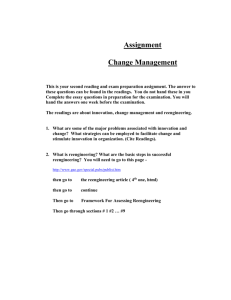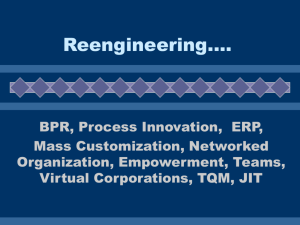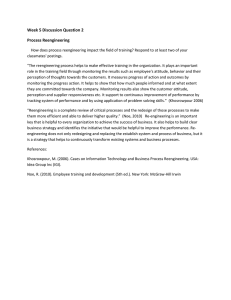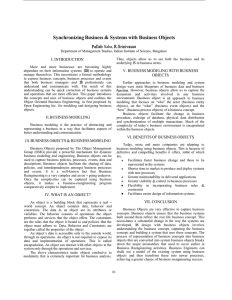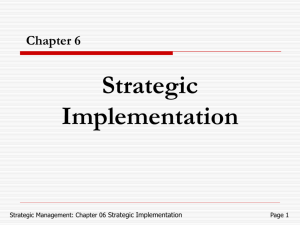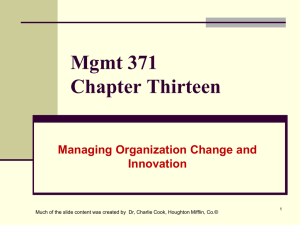Document 15063097
advertisement
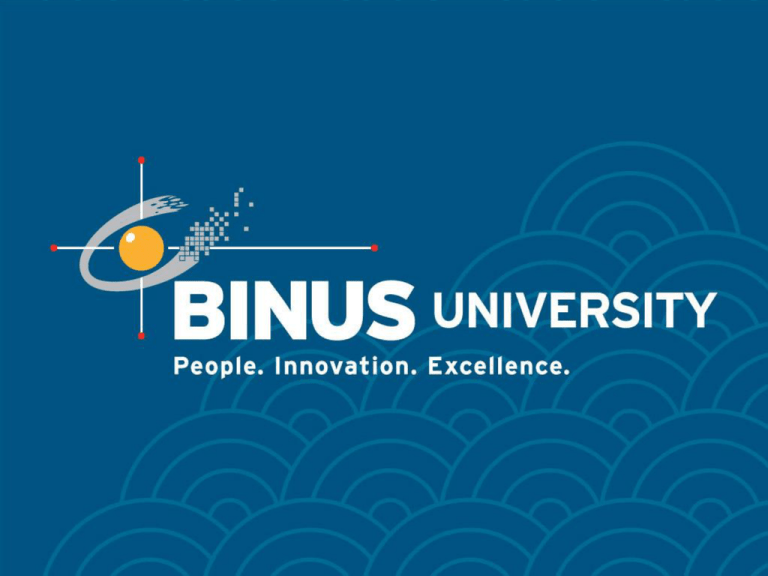
Matakuliah Tahun : M0734-Business Process Reenginering : 2010 The Development of Business Process Reengineering (BPR) Pertemuan 4 What is BPR? • The fundamental rethinking and radical redesign of business process to achieve dramatic improvements in critical, contemporary measures of performance, such as cost, quality, service, and speed • One approach for redesigning the way work is done to better support the organization’s mission and reduce cost 3 • Reengineering starts with a high-level assessment of the organization’s mission, strategic goals, and customer needs • BPR began as a private sectortechnique to help organizations fundamentally rethink how they do their work in order to dramatically improve customer service, cut operational costs, and become worldclass competitors • A key stimulus for reengineering has been the continuing development and deployment of sophisticated information systems and networks • Leading organizations are becoming bolder in using this technology to support innovative business processes, rather than refining current ways of doing work 4 Reengineering Guidance & Relationship of Mission to Information Technology Mission Defines Accomplish Work Processes Execute Guide Decisions Consider Supports Information Employs Processes Technology 5 • • • • • • • • To understand reengineering, it is important to understand the concept of the value chain The value chain consists of the primary and secondary activities of the firm Reengineering strives for the efficient redesign of the company’s value chain The primary activities of the firm include inbound logistics, operations, outbound logistics, marketing, and service These activities are essential to creating, producing, marketing, selling, and supporting a product or service An information system supports each of these primary activities This information system can cut the cost of performing a value activity, or it can be used to provide a “value-added” feature to the product or service For example, the value activity, called outbound logistics, deals with processing orders to customers. An online order entry system which enables customers to order electronically can cut the time and cost of this value activity. The value activity, called service, can be supported by remote machine diagnostics, which “adds value” by providing online diagnostic support 6 The Value Chain Primary Activities Primary Inbound Operations Outbound Logistics Marketing Sales Service Functions Materials delivery Manufacturing; assembly Order shipping Advertising; promotion Service; Information supporting activities Automated warehousing Manufacturing systems Online order systems Marketing systems Remote diagnostics 7 The Value Chain Secondary Activities Support Activities Information Systems Organization Electronic mail (facilitates communications throughout the Human resources Skill databases Technology Computer-aided design and manufacturing Purchasing Online links to suppliers’ databases 8 Motivation for Business Reengineering Driving Forces External Responses Internal Changes Deregulation Customer focus Reengineering work Consolidation Quality emphasis Corporate cultural change Changing values Responsiveness Teams Customer sophistication Strategic relationships Empower workers Technological advances Downsizing Quality management 9 • In today’s economy, some of the major motivations for streamlining and reenginering business processes are customer sophistication, deregulation, and increasing competition on a global level • These driving forces provide a rationale for re-thinking existing business practices and using technology to create new forms of work 10 Work Environment with Fragmented Business Processes 11 Reengineering Example : Ford Motor Accounts Payable 12 Elements for Business Reengineering Elements Activities Business Processes Do not automate existing business processes; break away from Integration Integrate business processes Technology Use technology to redesign business processes Cross-functional coordination Redesign business processes from a cross-functional view Timing Improve processes continuously Objective Implement market-driven strategies designed to provide a 13 Reengineering Case Studies Before Reengineering After Reengineering Business Impact Ford Motor Company Accounts Payable Independent databases maintained receiving, and accounts payable An integrated database supporting (e.g., purchasing, receiving, accounts Fewer inconsistencies; reduction in better responsiveness to customers IBM Credit Authorization Multi-step credit authorization multiple departments and multiple a pricer, checker) A “deal structurer” makes the credit decision, using multiple databases Timely decision making; more service; elimination of redundant bottlenecks Xerox Product Development Sequential product development meant that workers had to wait until were completed Concurrent engineering, using a database and a computer-assisted Elimination of bottlenecks and development; responsiveness to Wal-Mart Inventory Management Wal-Mart ordered its own stock of from vendors; deal with excess insufficient inventory Wal-Mart let its vendor, Proctor and replenish its inventory according to Better inventory management; more inventory replenishment Hewlett-Packard’s Purchasing Process Decentralized purchasing led to a wide discounts Central negotiation of corporate and use a shared database of Cost savings through the use of discounts 14 Reengineering Example : Xerox Befor e 15 Reengineering Example : Xerox After 16 Restructuring Business Process Means Restructuring Jobs Organization Traditional Reengineered Narrow Broad Hierarchical Flat Vertical Horizontal Work rules Procedures Judgment Management Supervision Leadership People skills needed Structured Adaptive Job design Structure Career moves 17 Process Modeling • • In order to depict the changes in data and processes associated with business reengineering, a commonly used tool in systems analysis is the process model The process model consists of five objects : – The business process : the process depicts the business activities which are accomplished (e.g., check credit, mail invoice) – The data store : the store depicts data that are needed by the business processes – The data flow : the flow depicts data being transferred from a process to another process or between a process and a data store – The organizational unit : the organizational unit depicts the units of the organization in which these processes take place (e.g., Accounts Receivable, Sales) – The event, including triggers and outcomes : a trigger is an event which “triggers” a process, and an outcome is an event which results from a process 18 Making Reengineering Work Company Redesigned Before After BAI (Banca di America Branch customer 64 activities, 9 forms, 14 25 activities, 2 forms, 2 AT&T PBX sales 12 project handoffs 3 handoffs Siemen Nixdorf Field service 30 support centers; headcount 5 support centers; 800 19

